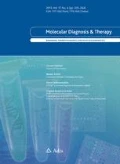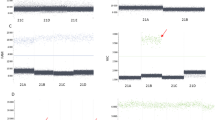Abstract
Digital PCR (dPCR) approaches have been developed for the detection of nucleic acids of low abundance, such as cell-free DNA, and represent an attractive and sensitive alternative to conventional methods, particularly in the field of non-invasive prenatal diagnosis (NIPD). In this review, we present the principle of dPCR and its applications in the field of prenatal diagnosis from current and emerging uses, such as fetal gender determination, rhesus blood group D antigen genotyping, or monogenic disorders prenatal testing, to future applications, such as the diagnosis and monitoring of pregnancy-related disorders. We also address considerations for implementation of the method in a clinical laboratory and discuss the competiveness of dPCR over other technologies such as quantitative PCR or massively parallel sequencing.


Similar content being viewed by others
References
Nawroz H, Koch W, Anker P, Stroun M, Sidransky D. Microsatellite alterations in serum DNA of head and neck cancer patients. Nat Med. 1996;2:1035–7.
Chen XQ, Stroun M, Magnenat JL, Nicod LP, Kurt AM, Lyautey J, et al. Microsatellite alterations in plasma DNA of small cell lung cancer patients. Nat Med. 1996;2:1033–5.
Lo YM, Corbetta N, Chamberlain PF, Rai V, Sargent IL, Redman CW, et al. Presence of fetal DNA in maternal plasma and serum. Lancet. 1997;350:485–7.
Tabor A, Alfirevic Z. Update on procedure-related risks for prenatal diagnosis techniques. Fetal Diagn Ther. 2010;27:1–7.
Barrett AN, Zimmermann BG, Wang D, Holloway A, Chitty LS. Implementing prenatal diagnosis based on cell-free fetal DNA: accurate identification of factors affecting fetal DNA yield. PLoS One. 2011;6:e25202.
Lo YMD, Chan KC, Sun H, Chen EZ, Jiang P, Lun FM, et al. Maternal plasma DNA sequencing reveals the genome-wide genetic and mutational profile of the fetus. Sci Transl Med. 2010;2:61ra91.
Vogelstein B, Kinzler KW. Digital PCR. Proc Natl Acad Sci USA. 1999;96:9236–41.
Sykes PJ, Neoh SH, Brisco MJ, Hughes E, Condon J, Morley AA. Quantitation of targets for PCR by use of limiting dilution. Biotechniques. 1992;13:444–9.
Basu AS. Digital assays part i: partitioning statistics and digital PCR. SLAS Technol. 2017;22:369–86.
Hindson BJ, Ness KD, Masquelier DA, Belgrader P, Heredia NJ, Makarewicz AJ, et al. High-throughput droplet digital PCR system for absolute quantitation of DNA copy number. Anal Chem. 2011;83:8604–10.
Milbury CA, Zhong Q, Lin J, Williams M, Olson J, Link DR, et al. Determining lower limits of detection of digital PCR assays for cancer-related gene mutations. Biomol Detect Quantif. 2014;1:8–22.
Zonta E, Garlan F, Pécuchet N, Perez-Toralla K, Caen O, Milbury C, et al. Multiplex detection of rare mutations by picoliter droplet based digital PCR: sensitivity and specificity considerations. PLoS One. 2016;11:e0159094.
Spurgeon SL, Jones RC, Ramakrishnan R. High throughput gene expression measurement with real time PCR in a microfluidic dynamic array. PLoS One. 2008;3:e1662.
Morrison T, Hurley J, Garcia J, Yoder K, Katz A, Roberts D, et al. Nanoliter high throughput quantitative PCR. Nucleic Acids Res. 2006;34:e123.
Huggett JF, Cowen S, Foy CA. Considerations for digital PCR as an accurate molecular diagnostic tool. Clin Chem. 2015;61:79–88.
Baker M. Digital PCR hits its stride. Nat Methods. 2012;9:541–4.
Perez-Toralla K, et al. Digital PCR compartmentalization I. Single-molecule detection of rare mutations [in French]. Med Sci (Paris). 2015;31:84–92.
Dube S, Qin J, Ramakrishnan R. Mathematical analysis of copy number variation in a DNA sample using digital PCR on a nanofluidic device. PLoS One. 2008;3:e2876.
Denis JA, Guillerm E, Coulet F, Larsen AK, Lacorte J-M. The role of BEAMing and digital PCR for multiplexed analysis in molecular oncology in the era of next-generation sequencing. Mol Diagn Ther. 2017;21(6):587–600. https://doi.org/10.1007/s40291-017-0287-7.
Jacobs BKM, Goetghebeur E, Clement L. Impact of variance components on reliability of absolute quantification using digital PCR. BMC Bioinform. 2014;15:283.
Droplet Digital™ PCR applications guide. http://www.bio-rad.com/webroot/web/pdf/lsr/literature/Bulletin_6407.pdf. Accessed 31 Aug 2017
Huggett JF, Foy CA, Benes V, Emslie K, Garson JA, Haynes R, et al. The digital MIQE guidelines: minimum information for publication of quantitative digital PCR experiments. Clin Chem. 2013;59:892–902.
Chan KCA, Ding C, Gerovassili A, Yeung SW, Chiu RW, Leung TN, et al. Hypermethylated RASSF1A in maternal plasma: a universal fetal DNA marker that improves the reliability of noninvasive prenatal diagnosis. Clin Chem. 2006;52:2211–8.
Costa JM, Benachi A, Gautier E, Jouannic JM, Ernault P, Dumez Y. First trimester fetal sex determination in maternal serum using real-time PCR [in French]. Gynecol Obstet Fertil. 2002;30:953–7.
Finning KM, Martin PG, Soothill PW, Avent ND. Prediction of fetal D status from maternal plasma: introduction of a new noninvasive fetal RHD genotyping service. Transfusion (Paris). 2002;42:1079–85.
Devaney SA, Palomaki GE, Scott JA, Bianchi DW. Noninvasive fetal sex determination using cell-free fetal DNA: a systematic review and meta-analysis. JAMA. 2011;306:627–36.
Legler TJ, Müller SP, Haverkamp A, Grill S, Hahn S. Prenatal RhD testing: a review of studies published from 2006 to 2008. Transfus Med Hemother. 2009;36:189–98.
Tsui NBY, Hyland CA, Gardener GJ, Danon D, Fisk NM, Millard G, et al. Noninvasive fetal RHD genotyping by microfluidics digital PCR using maternal plasma from two alloimmunized women with the variant RHD(IVS3 + 1G > A) allele. Prenat Diagn. 2013;33:1214–6.
Sillence KA, Roberts LA, Hollands HJ, Thompson HP, Kiernan M, Madgett TE, et al. Fetal sex and RHD genotyping with digital PCR demonstrates greater sensitivity than real-time PCR. Clin Chem. 2015;61:1399–407.
Svobodová I, Pazourková E, Hořínek A, Novotná M, Calda P, Korabečná M. Performance of droplet digital PCR in non-invasive fetal RHD genotyping—comparison with a routine real-time PCR based approach. PLoS One. 2015;10:e0142572.
Orhant L, Rondeau S, Vasson A, Anselem O, Goffinet F, Allach El Khattabi L, et al. Droplet digital PCR, a new approach to analyze fetal DNA from maternal blood: application to the determination of fetal RHD genotype. Ann Biol Clin (Paris). 2006;74:269–77.
Sillence KA, Halawani AJ, Tounsi WA, Clarke KA, Kiernan M, Madgett TE, et al. Rapid RHD zygosity determination using digital PCR. Clin Chem. 2017;63:1388–97.
Orhant L, Anselem O, Fradin M, Becker PH, Beugnet C, Deburgrave N, et al. Droplet digital PCR combined with minisequencing, a new approach to analyze fetal DNA from maternal blood: application to the non-invasive prenatal diagnosis of achondroplasia. Prenat Diagn. 2016;36:397–406.
Gruber A, Pacault M, El Khattabi LA, Vaucouleur N, Orhant L, Bienvenu T, et al. Non-invasive prenatal diagnosis of cystic fibrosis and neurofibromatosis type 1 from maternal plasma: detection of paternally-inherited mutations using droplet digital PCR. Clin Chem Lab Med. 2017 (accepted).
Debrand E, Lykoudi A, Bradshaw E, Allen SK. A non-invasive droplet digital PCR (ddPCR) assay to detect paternal CFTR mutations in the cell-free fetal DNA (cffDNA) of three pregnancies at risk of cystic fibrosis via compound heterozygosity. PLoS One. 2015;10:e0142729.
Lo YMD, Lun FM, Chan KC, Tsui NB, Chong KC, Lau TK, et al. Digital PCR for the molecular detection of fetal chromosomal aneuploidy. Proc Natl Acad Sci USA. 2007;104:13116–21.
Fan HC, Blumenfeld YJ, El-Sayed YY, Chueh J, Quake SR. Microfluidic digital PCR enables rapid prenatal diagnosis of fetal aneuploidy. Am J Obstet Gynecol. 2009;200:543.e1–7.
Evans MI, Wright DA, Pergament E, Cuckle HS, Nicolaides KH. Digital PCR for noninvasive detection of aneuploidy: power analysis equations for feasibility. Fetal Diagn Ther. 2012;31:244–7.
El Khattabi LA, Rouillac-Le Sciellour C, Le Tessier D, Luscan A, Coustier A, Porcher R, et al. Could digital PCR be an alternative as a non-invasive prenatal test for trisomy 21: a proof of concept study. PLoS One. 2016;11:e0155009.
Taylor-Phillips S, Freeman K, Geppert J, Agbebiyi A, Uthman OA, Madan J, et al. Accuracy of non-invasive prenatal testing using cell-free DNA for detection of down, Edwards and Patau syndromes: a systematic review and meta-analysis. BMJ Open. 2016;6:e010002.
Skrzypek H, Hui L. Noninvasive prenatal testing for fetal aneuploidy and single gene disorders. Best Pract Res Clin Obstet Gynaecol. 2017;42:26–38.
Lo YMD, Chiu RWK. Genomic analysis of fetal nucleic acids in maternal blood. Annu Rev Genom Hum Genet. 2012;13:285–306.
Daley R, Hill M, Chitty LS. Non-invasive prenatal diagnosis: progress and potential. Arch Dis Child Fetal Neonatal Ed. 2014;99:F426–30.
El Karoui N, Zhou W, Whittemore AS. Getting more from digital SNP data. Stat Med. 2006;25:3124–33.
Lun FMF, Tsui NB, Chan KC, Leung TY, Lau TK, Charoenkwan P, et al. Noninvasive prenatal diagnosis of monogenic diseases by digital size selection and relative mutation dosage on DNA in maternal plasma. Proc Natl Acad Sci USA. 2008;105:19920–5.
Barrett AN, McDonnell TCR, Chan KCA, Chitty LS. Digital PCR analysis of maternal plasma for noninvasive detection of sickle cell anemia. Clin Chem. 2012;58:1026–32.
Tsui NBY, Kadir RA, Chan KC, Chi C, Mellars G, Tuddenham EG, et al. Noninvasive prenatal diagnosis of hemophilia by microfluidics digital PCR analysis of maternal plasma DNA. Blood. 2011;117:3684–91.
Hudecova I, Jiang P, Davies J, Lo YMD, Kadir RA, Chiu RWK. Noninvasive detection of F8 int 22 h-related inversions and sequence variants in maternal plasma of hemophilia carriers. Blood. 2017;130:340–7.
Srinivasan A, Bianchi DW, Huang H, Sehnert AJ, Rava RP. Noninvasive detection of fetal subchromosome abnormalities via deep sequencing of maternal plasma. Am J Hum Genet. 2013;92:167–76.
Zhao C, Tynan J, Ehrich M, Hannum G, McCullough R, Saldivar JS, et al. Detection of fetal subchromosomal abnormalities by sequencing circulating cell-free DNA from maternal plasma. Clin Chem. 2015;61:608–16.
Wapner RJ, Babiarz JE, Levy B, Stosic M, Zimmermann B, Sigurjonsson S, et al. Expanding the scope of noninvasive prenatal testing: detection of fetal microdeletion syndromes. Am J Obstet Gynecol. 2015;212:332.e1–9.
Vora NL, OʼBrien BM. Noninvasive prenatal testing for microdeletion syndromes and expanded trisomies: proceed with caution. Obstet Gynecol. 2014;123:1097–9.
Hwang VJ, Maar D, Regan J, Angkustsiri K, Simon TJ, Tassone F. Mapping the deletion endpoints in individuals with 22q11.2 deletion syndrome by droplet digital PCR. BMC Med Genet. 2014;15:106.
Pretto D, Maar D, Yrigollen CM, Regan J, Tassone F. Screening newborn blood spots for 22q11.2 deletion syndrome using multiplex droplet digital PCR. Clin Chem. 2015;61:182–90.
Wong FCK, Lo YMD. Prenatal diagnosis innovation: genome sequencing of maternal plasma. Annu Rev Med. 2016;67:419–32.
Yuen RK, Peñaherrera MS, von Dadelszen P, McFadden DE, Robinson WP. DNA methylation profiling of human placentas reveals promoter hypomethylation of multiple genes in early-onset preeclampsia. Eur J Hum Genet. 2010;18:1006–12.
Xiang Y, Zhang X, Li Q, Xu J, Zhou X, Wang T, et al. Promoter hypomethylation of TIMP3 is associated with pre-eclampsia in a Chinese population. Mol Hum Reprod. 2013;19:153–9.
Redshaw N, Huggett JF, Taylor MS, Foy CA, Devonshire AS. Quantification of epigenetic biomarkers: an evaluation of established and emerging methods for DNA methylation analysis. BMC Genom. 2014;15:1174.
Poon LL, Leung TN, Lau TK, Lo YM. Presence of fetal RNA in maternal plasma. Clin Chem. 2000;46:1832–4.
Pang WWI, Tsui MH, Sahota D, Leung TY, Lau TK, Lo YM, et al. A strategy for identifying circulating placental RNA markers for fetal growth assessment. Prenat Diagn. 2009;29:495–504.
Hui L, Beard S, Hannan NJ. Measuring fetal brain and lung transcripts in amniotic fluid supernatant: a comparison of digital PCR and RT-qPCR methods. J Matern Fetal Neonatal Med. 2017;24:1–6. https://doi.org/10.1080/14767058.2017.1367378.
Kaitu’u-Lino TJ, Hastie R, Cannon P, Lee S, Stock O, Hannan NJ, et al. Stability of absolute copy number of housekeeping genes in preeclamptic and normal placentas, as measured by digital PCR. Placenta. 2014;35:1106–9.
Barrett AN, Chitty LS. Developing noninvasive diagnosis for single-gene disorders: the role of digital PCR. Methods Mol Biol. 2014;1160:215–28.
Hudecova I. Digital PCR analysis of circulating nucleic acids. Clin Biochem. 2015;48:948–56.
Acknowledgements
We thank all the clinical centers participating in the Diagnostic Ante Natal Non Invasif (DANNI) project. We are grateful to the geneticists, obstetricians, midwifes, nurses, and laboratory technicians and we thank the families for their participation. We also thank Mathilde Pacault and the French Digital PCR Working Group for our fruitful discussion.
Author information
Authors and Affiliations
Corresponding author
Ethics declarations
Conflict of Interest
Juliette Nectoux declares no conflicts of interest.
Funding
Funding was received from Agence de la Biomédecine (Project R13188KK), Vaincre la mucoviscidose (Project RC2013500852), and Association Française contre les Myopathies (Project AFM AO2019-No. 19832).
Rights and permissions
About this article
Cite this article
Nectoux, J. Current, Emerging, and Future Applications of Digital PCR in Non-Invasive Prenatal Diagnosis. Mol Diagn Ther 22, 139–148 (2018). https://doi.org/10.1007/s40291-017-0312-x
Published:
Issue Date:
DOI: https://doi.org/10.1007/s40291-017-0312-x




